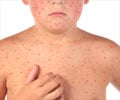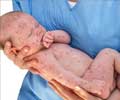Research aims to decipher how particular mutations contribute to the measles virus's propagation within the brain.

Brain tropism acquisition: The spatial dynamics and evolution of a measles virus collective infectious unit that drove lethal subacute sclerosing panencephalitis
Go to source) "Our study provides compelling data that shows how viral RNA mutated and spread throughout a human organ — the brain, in this case," says Roberto Cattaneo, Ph.D., a Mayo Clinic virologist who is a co-lead author on a new PLOS Pathogens study. "Our discoveries will help studying and understanding how other viruses persist and adapt to the human brain, causing disease. This knowledge may facilitate the generation of effective antiviral drugs."
‘Scientists traced how viral genomes inhabited the human brain; measles mutations helped spread from the frontal cortex outward. #measles #viralinfection’





Measles is one of the most contagious diseases. The measles virus infects the upper respiratory tract where it uses the trachea, or windpipe, as a trampoline to launch and spread through droplets dispersed when an infected person coughs or sneezes. Dr. Cattaneo pioneered studies on how the measles virus spreads throughout the body.
Exploration of Measles Virus
He first began to study the measles virus about 40 years ago and was fascinated by the rare, lethal brain disease called subacute sclerosing panencephalitis (SSPE), which occurs in about 1 in every 10,000 measles cases. It can take about five to 10 years after the initial infection for the measles virus to mutate and spread throughout the brain. Symptoms of this progressive neurological disease include memory loss, seizures and immobility. Dr. Cattaneo studied SSPE for several years until the lethal disease nearly disappeared as more people were vaccinated against measles.However, measles is resurging due to vaccine hesitancy and missed vaccinations. During the COVID-19 pandemic, millions of children missed receiving their measles vaccinations, which has resulted in an estimated 18% increase in measles cases and 43% increase in death from measles in 2021 compared to 2022 worldwide, according to a recent Centers for Disease Control and Prevention (CDC) report.
"We suspect SSPE cases will rise again as well. This is sad because this horrible disease can be prevented by vaccination. But now we are in the position to study SSPE with modern, genetic sequencing technology and learn more about it," says Iris Yousaf, co-lead author of the study and a fifth-year Ph.D. candidate at Mayo Clinic Graduate School of Biomedical Sciences.
Dr. Cattaneo and Yousaf had a unique research opportunity through a collaboration with the CDC. They studied the brain of a person who had contracted measles as a child and had succumbed to SSPE years later as an adult. They investigated 15 specimens from different regions of the brain and conducted genetic sequencing on each region to piece together the puzzle of how the measles virus mutated and spread.
Advertisement
"In this population, two specific genomes had a combination of characteristics that worked together to promote virus spread from the initial location of the infection — the frontal cortex of the brain — out to colonize the entire organ," says Dr. Cattaneo.
Advertisement
Reference:
- Brain tropism acquisition: The spatial dynamics and evolution of a measles virus collective infectious unit that drove lethal subacute sclerosing panencephalitis - (https://journals.plos.org/plospathogens/article?id=10.1371/journal.ppat.1011817)















